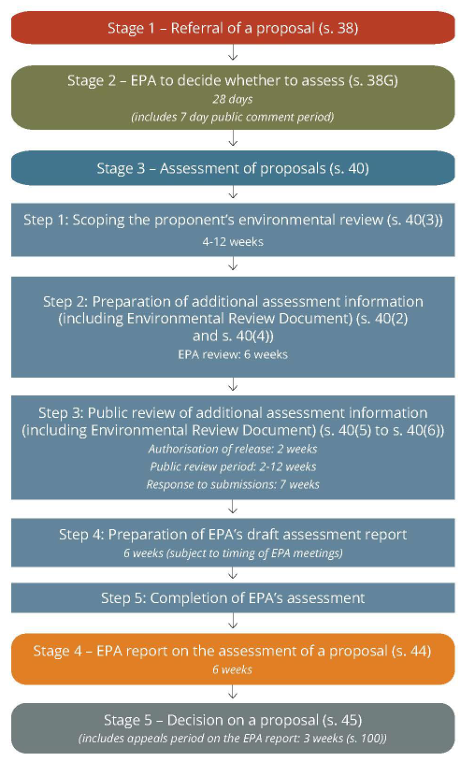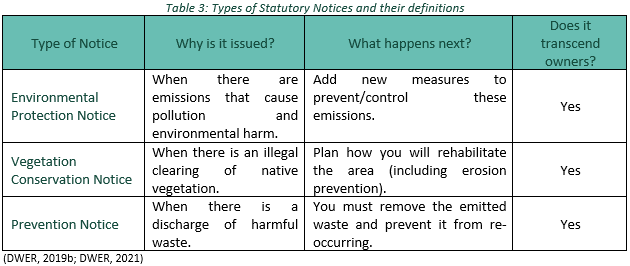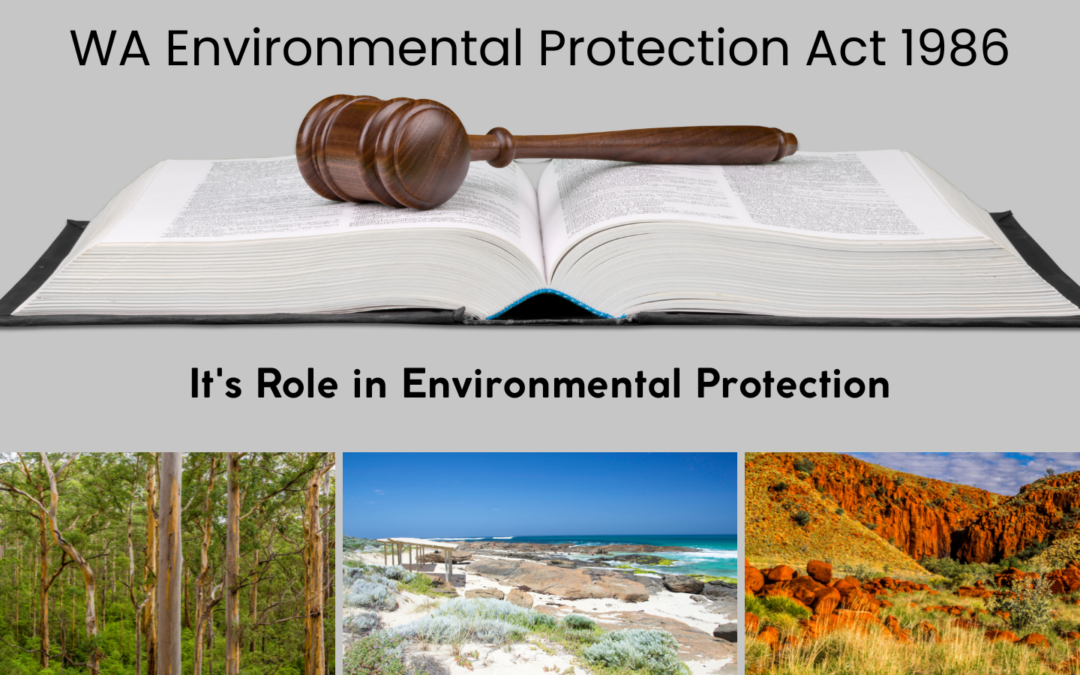The WA Environmental Protection Act 1986 (EP Act) was established to protect the environment from pollution and environmental harm through environmental protection policies and regulations that control land use and development throughout Western Australia (EPA, 2021a).
Under the EP Act, the release of emissions or clearing native vegetation is an offence unless you have an approval established through an Impact Assessment, works approval, prescribed premises licence, or clearing permit under the EP Act (DWER, 2019a).
This insight outlines some key aspects associated with the EP Act that a business and their employees should be aware of.
The Managing Authorities
The two authorities are responsible for implementing the EP Act. These are the Department of Water and Environmental Regulation (DWER) and the Environmental Protection Authority (EPA) (DWER, 2023a). DWER is responsible for supporting EPA under Part IV of the Act and for the assessment and compliance under Part V of the EP Act, which includes native vegetation clearing permits and works approvals and prescribed premises licenses.
The EPA is an independent authority appointed by the Minister for the Environment (EPA, 2023). The EPA defines its key responsibilities as – conducting environmental impact assessments, preparing statutory policies and guidelines for environmental protection and management and providing advice to the Minister for Environment. (EPA, 2023)

Environmental Impact Assessment- Triggers and Process
An Environmental Impact Assessment process may be triggered under Part IV of the EP Act when a proposal if implemented, could have significant impacts on environmental values or public health. To provide a systematic approach to impact assessment, environmental values are grouped into key themes: Sea, Land, Water, Air and People (EPA, 2021a). The assessment of an application under the EP Act Part IV follows five stages (Figure 1).

Stage One – Referral: Anyone can refer a proposal (including the general public) to the EPA if they are concerned that the proposal may significantly affect the environment (EPA, 2021b). This referral must be in writing and contain the proposed project’s scope and possible environmental impacts.
Stage Two – Referral Decision: The EPA will review the referral and release it to the public for seven days. The public is then able to provide advice to the EPA on whether they have concerns and if they feel the proposal should be formally assessed. The EPA can then use the referral information, public comments and additional information that might have been requested to make their assessment.
Stage Three – Impact Assessment: The proposal assessment is split into five steps.
Step One: The EPA will first scope the application and decide whether more information is needed to make a decision on a proposal. They will provide the applicant with a scoping document defining all the areas and key environmental factors that need more investigation (EPA, 2021c).
Step Two: Using the environmental scoping document as a guide, the applicant must then prepare this information in the form of an Environmental Review Document (ERD).
Step Three: The ERD may be released to the public for comments and questions, and the applicant must respond to the comments and requested information (EPA, 2021c). Note the release of an ERD for public review is determined by the EPA when determining if a proposal should be assessed under Part IV of the EP Act.
Step Four/Step Five: Once the EPA has gathered all the required information, they will begin the proposal assessment and draft an assessment report. This report will assess the proposal, any submissions made by the public, and whether the proposed environmental management plan will protect the area’s environmental values.
Stage Four – EPA Recommendation: The EPA then completes their assessment report on the proposal (including their recommendations for or against the proposal) and provides it to the Minister for Environment.
Stage Five – Decision: Once the Minister accepts the proposal, the EPA will publish the report, and the decision will be issued (EPA, 2021c).
Environmental Regulations and approvals.
Regulations and approvals for clearing native vegetation, works approvals and prescribed premises licensing are managed under Part V of the EPA Act. Part V defines what constitutes pollution and environmental harm and when it is considered an offence per the Act. The Act defines pollution as the negative alteration of the environment. Environmental harm is defined per the Act as harm to the environment involving the removal or destruction of native vegetation or causing the overall degradation of the environment.
There are two different overarching types of environmental harm listed in the Act; Serious and Material Environmental Harm (Table 1). DWER uses these definitions to understand when proposals should be referred to the EPA and to help the enforcement of violations of the Act.

Division two of Part V establishes the processes and permits needed to clear native vegetation in Western Australia. To clear vegetation, even if the vegetation is dead or you own the land, you need to apply for a Native Vegetation Clearing Permit (NVCP)– unless the activities are an exempt activity. Exemptions include; maintaining a fire break, clearance under a powerline, activities that have undergone an EP Act Part IV assessment or if there is a threat to someone’s life if you do not clear the vegetation (DWER, 2019b). Further information on exemptions are available in the DWER Guide to exemption and regulations for clearing native vegetation.
There are two types of NVCP, area permits and purpose permits (Table 2). An “Area permit” can only be applied for by the owner of land or where the applicant is undertaking the clearing on behalf of the landowner, while “Purpose permits” you do not have to be the owner of the land but you must have the authority under a written law or permission to access the land to conduct the clearing. An “Area permit” provides for clearing of defined areas specified in the permit, while “Purpose permits” are for clearing of different areas from time to time for a purpose specified in the permit (DMIRS, 2023).

Division three of Part V manages works approvals for construct and licenses to operate prescribed premises and conditions for regulating their emissions and discharges. A prescribed premises is defined as a premises with the potential to cause emissions and discharges into the environment (DWER, 2019b). There are over 89 categories of prescribed premises, such as an intensive piggery, crushing of building material or sugar milling/refining (a complete list can be found in Schedule 1 of The Environmental Protection Regulations 1987). DWER has commenced work on changes to Division three in the EP Act and information on these changes will be released via their website later in 2023.

Before you can construct or alter premises, which may cause it to become a prescribed premises, you must first acquire a works approval (DWER, 2019b). A works approval comes with a set of environmental conditions that authorises you to cause emissions and discharges into the environment during the construction and development of a prescribed premises. For example, constructing a solid waste facility will require dust monitors to be set up on the premises boundaries to capture dust emissions to protect nearby residents.

Once you have finished constructing the prescribed premises, you need to apply for a licence to operate it. Like works approvals, licences have conditions to minimise environmental harm and pollution from the prescribed premises (DWER, 2019b).
Statutory Notices
If a Company or an employee does not comply with the legislation or conditions on a licence, permits or works approvals, DWER can issue you with a statutory notice. A statutory notice is a written notice that describes the action that needs to be taken or ceased within a specific time frame; not complying with this notice is an offence (DWER, 2023b). There are many different types of statutory notices that DWER can issue a land user, such as an environmental protection notice, a vegetation conservation notice and a prevention notice (Table 3).

Enforcement
DWER has multiple methods to identify breaches in EP Act, such as using authorised persons to investigate prescribed premises. DWER’s responses will vary depending on the severity of the violation.
The Director General of DWER can appoint inspectors to gather information on areas of interest (such as prescribed premises). The information they can legally gather is broad and can include samples of waste, testing noise levels, and whether the requirements of the Act are being followed. Inspectors have entry power and powers to obtain information on any premises regulated by the Act, meaning they can enter a work site, look at documents and data anytime, and report their findings to their governing body.
If you are found to have breached the EP Act. You could be issued an environmental protection notice or have the property responsible for the emission seized. Prosecution will only be used as a last resort or when appropriate for the level of violation. You can appeal or challenge the department’s decision if you are subject to an infringement or statutory notice.
At Integrate Sustainability, our team has extensive experience with the EP Act and its associated permits and approvals. We can assist you and your business in ensuring your activities are in compliance with the EP Act. Don’t hesitate to contact us for assistance at 9468 0338 or enquiries@integratesustainability.com.au.
References
DMIRS. (2023). Native Vegetation Clearing Permits and Referrals.
DWER. (2015a). Notification of waste discharges. Retrieved from Department of Water and Environmental Regulation: https://www.der.wa.gov.au/your-environment/reporting-pollution/111-duty-to-notify-discharges-of-waste
DWER. (2019a). Industry Regulation Guide to Licensing. Retrieved from Department of Water and Environmental Regulation: https://www.wa.gov.au/service/building-utilities-and-essential-services/integrated-essential-services/guideline-industry-regulation-guide-licensing
DWER. (2019b). A guide to the exemptions and regulations for clearing native vegetation. Retrieved from The Department of Water and Environmental Regulation: https://www.der.wa.gov.au/our-work/clearing-permits/48-guidelines-clearing-permits
DWER. (2019b). Procedure – Prescribed premises works approvals and licences. Retrieved from Department of Water and Environmental Regulation: https://dwer.wa.gov.au/procedure/prescribed-premises-work-approvals-licences
DWER. (2021). Procedure – Native vegetation clearing permits. Retrieved from Department of Water and Environmental Regulation: https://dwer.wa.gov.au/procedure/native-vegetation-clearing-permit
DWER. (2023a). Department of Water and Environmental Regulation. Retrieved from Department of Water and Environmental Regulation: https://dwer.wa.gov.au/
DWER. (2023b). Environmental enforcement. Retrieved from Department of Water and Environmental Regulation: https://www.wa.gov.au/service/environment/business-and-community-assistance/environmental-enforcement#:~:text=An%20environmental%20protection%20notice%20(EPN,or%20environmental%20harm%20(ongoing).
EPA. (2021a). Statement of environmental principles, factors objectives and aims of the EIA. Retrieved from Environmental Protection Authority: https://www.epa.wa.gov.au/statement-environmental-principles-factors-and-objectives
EPA. (2021b). Instructions for the referral of a Proposal to the Environmental Protection Authority under Section 38 of the Environmental Protection Act 1986. Retrieved from Environmental Protection Authority: https://www.epa.wa.gov.au/forms-templates/s38-referral-instructions-and-form
EPA. (2021c). Environmental Impact Assessment (Part IV Divisions 1 and 2) Procedures Manual. Retrieved from Environmental Protection Authority: https://www.epa.wa.gov.au/procedures-manual
EPA. (2023). About the Environmental Protection Authority. Retrieved from Environmental Protection Authority: https://www.epa.wa.gov.au/about-environmental-protection-authority

